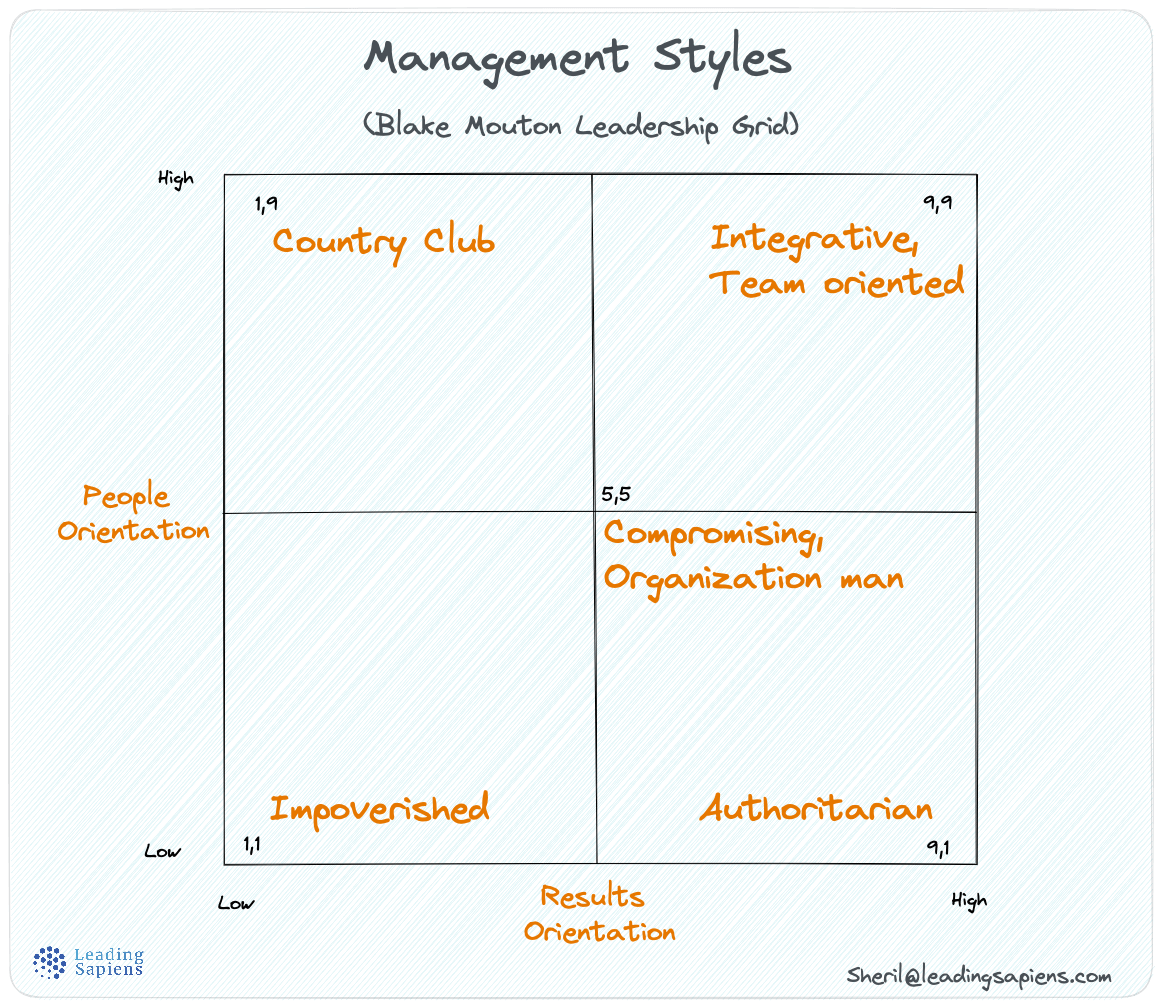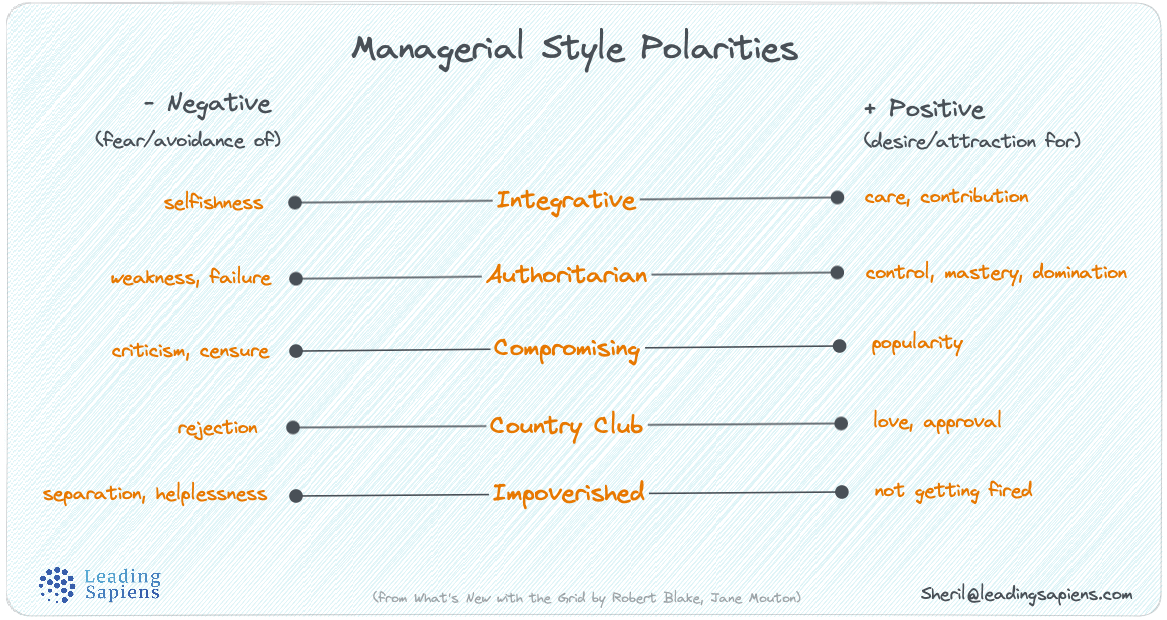LSW 21 👑What's your style?
Country club vs autocratic — typical patterns, and why there's no one best style.
Welcome to edition 21 of the leading sapiens weekly! Today, we look at the misunderstood idea of style. What’s your style of operating? Is there a universal style that’s more effective?
Business guru Jim Collins, who wrote Built to Last and Good to Great, has a simple formula for effectiveness:
Effective Leadership = Function + Style
No matter what role you are in, your effectiveness depends on how well you understand/execute the requirements of your role (function), and how you operate (your style). For today’s discussion, we'll focus on the latter.
In general, we make two mistakes about style:
First is to think that there is one universally effective style
The second is not understanding what your own unique style is, and what its drawbacks are
There is no universal style
You have to discover and cultivate your own elements of style, a distinctive leadership artistry that makes you effective at getting the right people to work passionately with you in accomplishing what must be done.
— Jim Collins
Early in our careers, we don’t have a good sense of what works and what doesn’t. But over time, through trial and error, we develop a unique style of working.
A common myth that trips many is to think that one style is more effective than others. This leads us to not trust our own experience, and instead changing it to fit what we think is the “best style”.
For example, successful leaders are thought to be outgoing and charismatic. This is patently false. This leads us to mimic someone else’s style, which is a guaranteed way of coming across as inauthentic.
Collins, who has closely studied hundreds of leaders, puts it this way:
Should everyone have the same leadership style? No, of course not. Your leadership style will be a function of your own unique personality characteristics.
Indeed, there are many effective styles. Some effective leaders are quiet, shy, and reserved; whereas others are outgoing and gregarious. Some are hyperactive and impulsive; others are more methodical. Some are old, wise, and experienced; others are young, brash, and adventurous. Some love to give speeches; others are nervous in front of a crowd. Some are charismatic; others are not. (Do not confuse leadership with charisma. Charisma does not equal leadership, and some of the most effective leaders have very little charisma.)
Examine the spectrum of world leaders and notice how much their styles differ: Mahatma Gandhi (frail and soft-spoken), Abraham Lincoln (melancholy and thoughtful), Winston Churchill (the fierce and indomitable bulldog), Margaret Thatcher (stern and tenacious, the “Iron Lady”), Martin Luther King Jr. (impassioned, eloquent). Yet, in spite of the wide range of styles, each of these leaders was highly effective.
Cultivate your own style; don’t try to be someone you’re not or to take on a style that doesn’t fit. Can you imagine Winston Churchill trying to imitate Gandhi’s style, wearing a loincloth and speaking in a soft, almost inaudible voice? Conversely, can you imagine Gandhi chewing on big fat cigars and growling, “Our policy is to wage war, by sea, land, and air, with all our might and all the strength God can give us . . . ”? These images are absurd. But they’re no more absurd than if you try to ape someone else’s style.
An effective style grows from within you. It should be entirely yours. No one except you should have a style exactly like yours.
— from BE 2.0 (Beyond Entrepreneurship 2.0) by Jim Collins
Having a unique style of operating doesn’t necessarily mean you can do whatever you like. Certain styles are more suited for different situations and organizational setups.
Given that there’s a wide range of effective styles, why is it that many folks get tripped up in their careers specifically because of their style?
This is where understanding the nuances of your own style and its blindspots is useful.
Understanding your style
The key is to remember that you in fact do have one, and that there are blindspots with each approach.There are many tools to figure this out.
A decent starter tool to understand your style is the Blake Mouton Leadership Grid. It identifies five different styles of operating, and what each style prioritizes and ignores.
For example, the authoritarian style is always driving towards control and mastery, but it stems from wanting to avoid failure and not showing weakness.
For a deeper dive into the Leadership Grid, you can go to the main article by clicking the images below:
Spend some time with the grid to figure out where you fall and what your default tendencies are. Most of us will be a hybrid.
The idea is not to identify an exact style, but rather what you are more inclined towards, and how that creates blindspots and blinds us to potentially different approaches.
I am curious to know what you find, and if you need anything clarified. You can reply to this email, and I’ll be happy to address your questions in future editions.
That’s it for this edition. Have a fantastic week!



